Over-the-Air Firmware Updates for Constrained NB-IoT Devices
Abstract
1. Introduction
2. Related Work
3. System Architecture
3.1. System Overview
- Sensor: It is a device connected to the NB-IoT network and senses various data such as temperature, humidity, and GPS position. It sends the sensed data periodically to a server via the NB-IoT network. The sensor needs to update its functionalities and becomes a target for the wireless firmware update over NB-IoT.
- Server: It is a self-deployed server connected to the Internet or a cloud service. It is used to maintain the database of the system and store the sensors’ identities and measurements. In addition to that, the server manages firmware versions and handles the sensors’ firmware update process. The update process can be triggered automatically by the server application or manually by the administrator using a web interface. Before transferring the firmware update file, the server notifies all the registered sensors about the upcoming files via NB-IoT.
- Push firmware update: Whenever a new firmware version is available, the server starts the update process.
- Pull firmware update: In this case, the sensor or the user at the sensor-side can initiate the update process. Practically, the sensors have a dedicated button that needs to be long pressed at bootup to start the firmware update.
- Notification about the update: The availability of a new firmware version should be notified to all the eligible sensors, which is done by the server.
- Version control at server-side: The server should manage all the firmware versions so that the firmware rollback is possible.
- Authenticity of update file source: The sensors should accept the firmware updates only from authenticated servers.
- Reliability in transfer: Packet loss or file corruption can affect firmware update operations and can fail the process. Therefore, the file transfer protocol should be reliable, which is generally controlled by the destination-feedback mechanism.
- Integrity of the firmware-image: The complete transfer of the firmware should be verified in a way so that a corrupted file can be rejected.
- Backward compatibility: The sensors should be able to revert the firmware version to the last running one. To support backward compatibility, the sensor needs to have a large flash memory, which could affect the cost of its deployment.
- Hindrance to the user data communication: The firmware update files should be transferred so that they do not block the main data communication processes.
- Automated process: The complete process of updating should be automated such as the sensors should be able to boot automatically to the new firmware; it should check the integrity, negotiate the timing of the update, and much more.
- Secure Channel: The communication between the server and the sensor should be secure. A secure handshake should be performed to negotiate security parameters, and transmitted data should be encrypted. Furthermore, the firmware can be signed for additional security.
3.2. System Prototype
- STM32 Nucleo: The development board STM32 Nucleo L496ZG is used to build the prototype. It runs both the sensor application and the bootloader for data reporting and firmware updates. It has many peripherals, and internal flash memory of one megabyte (MB) that can host both the application and the bootloader firmware [27].
- NB-IoT module: It is the communication module used to receive the firmware update file from the server using the NB-IoT network. It can also be used to exchange user data between the device and the server. We have used a SARA-N210 [28] based module as an NB-IoT device that is connected to the STM32 Nucleo board via UART and controlled via AT commands. The operator issues SIM cards for the sensors to access the network. Each SIM card has a unique International Mobile Equipment Identity (IMEI) that is used to identify the devices.
- Octa Extension board: A custom board plugged in the STM32 Nucleo GPIO socket that provides different connectors where various sensors and modules can be added.
- Flash memory: This is an extended external non-volatile memory and is used to store sensor application data and the downloaded firmware segments when performing the firmware update. It also hosts the mailbox to share data between the application and the bootloader. We have used S25FL256 flash memory [29] of 32 MB. It is soldered to the Octa Extension board and controlled via SPI from the STM32 Nucleo board.
- Sensor modules: There can be many sensor modules plugged into the Octa extension board and controlled by the STM32 Nucleo board using SPI, I2C, or UART. These modules are used to gather data such as GPS coordinates, temperature, and humidity.
3.3. Flash Memory Layout
- Application usage: This section is dedicated to the sensor usage such as storing data or future usage to implement new additional features.
- Downloaded firmware: This area is used by the bootloader to store the downloaded firmware from the server during the firmware update process and before moving it to the internal flash. The firmware is sent from the server in segments, so the bootloader stores each one in this area using a buffering mechanism allowing it to be stored in contiguous blocks.
- Mailbox: As already explained, it is used to share data between the application and the bootloader regarding firmware update requests and application status. When a firmware update notification is received from the server, the sensor application updates this area that contains various fields such as application status which represents the current state of the application as defined in Table 1, firmware length, packet number to know the next expected segment counter, firmware checksum to validate its integrity, and token which is used to establish a firmware update session between the bootloader and the server. A token is generated by the server dedicated to a sensor and sent with the firmware update notification. Furthermore, some memory areas are reserved for future use.
3.4. Firmware Update Procedure and Application Data
- The user powers on the sensor. Its bootloader starts the application after checking the OK status of the application in the mailbox. The application initializes the system, the sensors and the NB-IoT module, and connects to the NB-IoT network. It sends an identification message to the server containing the IMEI of the sensor, the IP address of the NB-IoT module, the application software version, and the timestamp. Later, it starts recording the sensors’ data and sends it periodically to the server.
- The second step is enabling firmware updates. When it is enabled by the user, the server sends a firmware update notification to the sensor containing the size of the firmware, number of packets, checksum, and a token. As shown in Figure 7, the application writes this information in the mailbox and sets the application status field to the firmware update, then jumps to the bootloader.
- The final step is the bootloader operations. The bootloader initializes the system and required modules, loads the mailbox data from the external flash and checks the application status field. The status is firmware update request, the bootloader executes the firmware update operation as described in S3 and S4. These steps are detailed in Figure 8 that include firmware segments download, writing segments in external flash memory, writing firmware in internal flash memory, and finally notifying the successful update operation and jumping to a new application.
3.5. Server-Sensor Messages Format
3.6. Software Architecture
3.6.1. Sensor
- Application: The main program of the sensor application. It initializes the system, the sensors and the NB-IoT module, and connects to the NB-IoT network. Then it starts gathering data from the sensors and sends them periodically to the server via the NB-IoT network.
- Bootloader: The main program of the sensor bootloader. It initializes the system and reads the application status in the mailbox. If the status is OK, it jumps to the application. If not, it initializes the NB-IoT module and connects to the NB-IoT network. Then it starts performing the firmware update operations.
- HAL: STM32 standard hardware abstraction layer assuring the portability of the software applications between different STM32 boards.
- SARA-N210 NB-IoT driver: A C++ driver class that configures and manages the communication over NB-IoT of the SARA-N210 NB-IoT module via AT commands using the serial port. It uses the standard STM32 serial driver.
- S25FL256 flash memory driver: A C++ driver class that initializes the S25FL256 external flash memory and manages the read and write operations via SPI. It uses the standard STM32 SPI driver.
- Various sensors drivers: The temperature, GPS, humidity and other sensors drivers are used to initialize the sensors and read their values.
- STM32 drivers: Standard STM32 peripherals drivers such as I2C, SPI, UART, etc...
3.6.2. Server
- socket: The standard Python low-level networking interface library.
- mysql connector: It is used as a standardized database driver for MySQL database.
- mysql server: A database server that hosts the databases and manages all the clients’ requests.
- database: It stores sensors’ information in three tables. The first one is Sensors which stores the IMEI, the IP address, the software version, the last firmware update status and the timestamps of a sensor. The second one is Measurement table which stores IMEI, power, timestamps of the measurements and the values of the different sensors. The third one is Firmware table which contains the path of the recent firmware and an enable field of the download.
- Application: The script that stores all the sensor’s measurements in the database and handles firmware update operations of the sensors. It listens on UDP sockets and parses received messages from the sensors. It puts sensors’ identities and measurements, respectively, in the sensors and measurements database tables. It also triggers the firmware update of the sensors and handles the exchange with the sensors’ bootloaders during the process. It runs as a daemon to be active on booting up the server.
4. Experimental Validation
4.1. Evaluation Criteria
4.1.1. Power Consumption
4.1.2. Transmission Latency
5. Discussion
6. Conclusions
Author Contributions
Funding
Institutional Review Board Statement
Informed Consent Statement
Data Availability Statement
Conflicts of Interest
References
- Sultania, A.K.; Zand, P.; Blondia, C.; Famaey, J. Energy Modeling and Evaluation of NB-IoT with PSM and eDRX. In Proceedings of the IEEE Globecom Workshops (GCWkshps), Abu Dhabi, United Arab Emirates, 9–13 December 2018; pp. 1–7. [Google Scholar]
- Xu, M.; Huber, M.; Sun, Z.; England, P.; Peinado, M.; Lee, S.; Marochko, A.; Mattoon, D.; Spiger, R.; Thom, S. Dominance as a New Trusted Computing Primitive for the Internet of Things. In Proceedings of the 2019 IEEE Symposium on Security and Privacy (SP), San Francisco, CA, USA, 19–23 May 2019; pp. 1415–1430. [Google Scholar]
- Langiu, A.; Boano, C.A.; Schuß, M.; Romer, K. UpKit: An Open-Source, Portable, and Lightweight Update Framework for Constrained IoT Devices. In Proceedings of the 39th IEEE International Conference on Distributed Computing Systems (ICDCS), Dallas, TX, USA, 7–10 July 2019; pp. 1–12. [Google Scholar]
- Nikolov, N. Research Firmware Update Over the Air from the Cloud. In Proceedings of the XXVII International Scientific Conference Electronics, Sozopol, Bulgaria, 13–15 September 2018. [Google Scholar]
- Chandra, H.; Anggadjaja, E.; Wijaya, P.S.; Gunawan, E. Internet of Things: Over-the-air (OTA) firmware update in lightweight mesh network protocol for smart urban development. In Proceedings of the 22nd Asia-Pacific Conf. Commun. (APCC), Yogyakarta, Indonesia, 25–27 August 2016; pp. 115–118. [Google Scholar]
- Texas Instruments. Z-Stack API[R]; Texas Instruments, Inc.: San Diego, CA, USA, 2009. [Google Scholar]
- Shen, L.; Li, N.; Wang, S. Optimization on zigbee ota technique. In Proceedings of the Advanced Information Management, Communicates, Electronic and Automation Control Conference (IMCEC), Xi’an, China, 3–5 October 2016; pp. 119–122. [Google Scholar]
- Feng, T. Zigbee-Based Firmware Updating Algorithms in Smart Home Environment. Ph.D. Thesis, University of Essex, Colchester, UK, 2017. [Google Scholar]
- Tsoukaneri, G.; Condoluci, M.; Mahmoodi, T.; Dohler, M.; Marina, M.K. Group Communications in Narrowband-IoT: Architecture, Procedures, and Evaluation. IEEE Internet Things J. 2018, 5, 1539–1549. [Google Scholar] [CrossRef]
- Evolved Universal Terrestrial Radio Access (E-UTRA); Radio Resource Control (RRC). Protocol Specification, 3GPP Standard TS 36.331. Available online: https://portal.3gpp.org/desktopmodules/Specifications/SpecificationDetails.aspx?specificationId=2440 (accessed on 1 October 2022).
- Feltrin, L.; Tsoukaneri, G.; Condoluci, M.; Buratti, C.; Mahmoodi, T.; Dohler, M.; Verdone, R. Narrowband IoT: A Survey on Downlink and Uplink Perspectives. IEEE Wirel. Commun. 2019, 26, 78–86. [Google Scholar] [CrossRef]
- Gonzalez, D.L. Theoretical and Experimental Analysis of NB-IoT Technology. Bachelor’s Thesis, Universitat Politècnica de Catalunya, Barcelona, Spain, 2019. [Google Scholar]
- Nikic, V.; Bortnik, D.; Lukic, M.; Mezei, I. Firmware Updates Over The Air Using NB-IoT Wireless Technology. In Proceedings of the 2021 29th Telecommunications Forum (TELFOR), Belgrade, Serbia, 23–24 November 2021; pp. 1–4. [Google Scholar]
- Alobaidy, H.; Singh, M.J.; Nordin, R.; Abdullah, N.; Wei, C.G.; Soon, M.L.S. Real-world evaluation of power consumption and performance of NB-IoT in Malaysia. IEEE Internet Things J. 2021, 9, 11614–11632. [Google Scholar] [CrossRef]
- Khan, S.Z.; Alam, M.M.; Moullec, Y.; Kuusik, A. Parand, S.; Verikoukis, C. An Empirical Modeling for the Baseline Energy Consumption of an NB-IoT Radio Transceiver. IEEE Internet Things J. 2021, 19, 14756–14772. [Google Scholar] [CrossRef]
- Yeoh, C.Y.; Man, A.; Ashraf, Q.M.; Samingan, A.K. Experimental assessment of battery lifetime for commercial off-the-shelf NB-IoT module. In Proceedings of the 20th International Conference on Advanced Communication Technology (ICACT), Chuncheon, Korea, 11–14 February 2018; pp. 223–228. [Google Scholar]
- Michelinakis, F.; Al-Selwi, A.S.; Capuzzo, M.; Zanella, A.; Mahmood, K.; Elmokashfi, A. Dissecting energy consumption of nb-iot devices empirically. IEEE Internet Things J. 2020, 2, 1224–1242. [Google Scholar] [CrossRef]
- Duhovnikov, S.; Baltaci, A.; Gera, D.; Schupke, D. Power consumption analysis of NB-IoT technology for low-power aircraft applications. In Proceedings of the 2019 IEEE 5th World Forum on Internet of Things (WF-IoT), Limerick, Ireland, 15–18 April 2019; pp. 719–723. [Google Scholar]
- Mender—Open Source Over-the-Air Software Updates for Linux Devices. Available online: https://mender.io/ (accessed on 18 September 2022).
- Arm Pelion IoT Platform. Available online: https://www.pelion.com (accessed on 18 September 2022).
- Balena—The Complete IoT Fleet Management Platform. Available online: https://www.balena.io (accessed on 18 September 2022).
- Particle. Available online: https://www.particle.io/ (accessed on 18 September 2022).
- FreeRTOS-Real-Time Operating System for Microcontrollers. [Online]. Available online: https://www.freertos.org/ (accessed on 18 September 2022).
- Secure OTA Firmware Update with STM32 Over 6LoWPAN and CoAP. Available online: https://www.hackster.io/firmwareguru/secure-ota-firmware-update-with-stm32-over-6lowpan-and-coap-cb1af3 (accessed on 28 September 2022).
- Lorawan OTA Update. Available online: https://docs.pycom.io/tutorials/networkprotocols/ota-lorawan/ (accessed on 28 September 2022).
- Firmware Updates over Low-Powered Wide Area Networks. Available online: https://os.mbed.com/blog/entry/firmware-updates-over-lpwan-lora/ (accessed on 28 September 2022).
- STM32 Nucleo L496ZG. Available online: https://www.st.com/en/evaluation-tools/nucleo-l496zg.html (accessed on 17 July 2022).
- SARA-N2 Series, u-Blox. Available online: https://www.u-blox.com/en/product/sara-n2-series (accessed on 17 July 2022).
- S25FL256 Cypress. Available online: https://www.cypress.com/file/448601/download (accessed on 17 July 2022).
- Pöhls, H.C.; Petschkuhn, B. Towards compactly encoded signed IoT messages. In Proceedings of the 2017 IEEE 22nd International Workshop on Computer Aided Modeling and Design of Communication Links and Networks (CAMAD), Lund, Sweden, 19–21 June 2017; pp. 1–6. [Google Scholar]
- Bideh, P.N.; Sönnerup, J.; Hell, M. Energy consumption for securing lightweight IoT protocols. In Proceedings of the 10th International Conference on the Internet of Things (IoT ’20), New York, NY, USA, 6–9 October 2020; pp. 1–8. [Google Scholar]
- Power Profiler Kit II. Available online: https://www.nordicsemi.com/Products/Development-hardware/Power-Profiler-Kit-2 (accessed on 20 July 2022).
- Cow Activity & GPS Tracker NB-IOT. Available online: https://iotfactory.eu/products/iot-sensors/cow-activity-gps-tracker-nbiot/ (accessed on 20 July 2022).
- NB007 NB-IoT & LTE-M Analyzer. Available online: http://en.hongdian.com/Products/Details/NBIoTandLTEM (accessed on 20 July 2022).
- Nieuwamerongen, S.V. Energy Consumption and Scalability of Transmitting Firmware Updates Over LoRa. Master’s Thesis, Delft University of Technology, Delft, The Netherland, 2021. [Google Scholar]
- Anastasiou, A.; Christodoulou, P.; Christodoulou, K.; Vassiliou, V.; Zinonos, Z. IoT Device Firmware Update over LoRa: The Blockchain Solution. In Proceedings of the 2020 16th International Conference on Distributed Computing in Sensor Systems (DCOSS), Marina del Rey, CA, USA, 25–27 May 2020; pp. 404–411. [Google Scholar]
- Abdelfadeel, K.; Farrell, T.; McDonald, D.; Pesch, D. How to Make Firmware Updates over LoRaWAN Possible. In Proceedings of the 2020 IEEE 21st International Symposium on A World of Wireless, Mobile and Multimedia Networks (WoWMoM), Cork, Ireland, 31 August 2020–3 September 2020; pp. 16–25. [Google Scholar]
- nRF9160. Available online: https://www.nordicsemi.com/Products/nRF9160 (accessed on 20 July 2022).
- LPWA BC95-G NB-IoT. Available online: https://www.quectel.com/product/lpwa-bc95-g-nb-iot (accessed on 20 July 2022).
- Basu, S.S.; Sultania, A.K.; Famaey, J.; Hoebeke, J. Experimental Performance Evaluation of NB-IoT. In Proceedings of the 2019 International Conference on Wireless and Mobile Computing, Networking and Communications (WiMob), Barcelona, Spain, 21–23 October 2019; pp. 1–6. [Google Scholar]
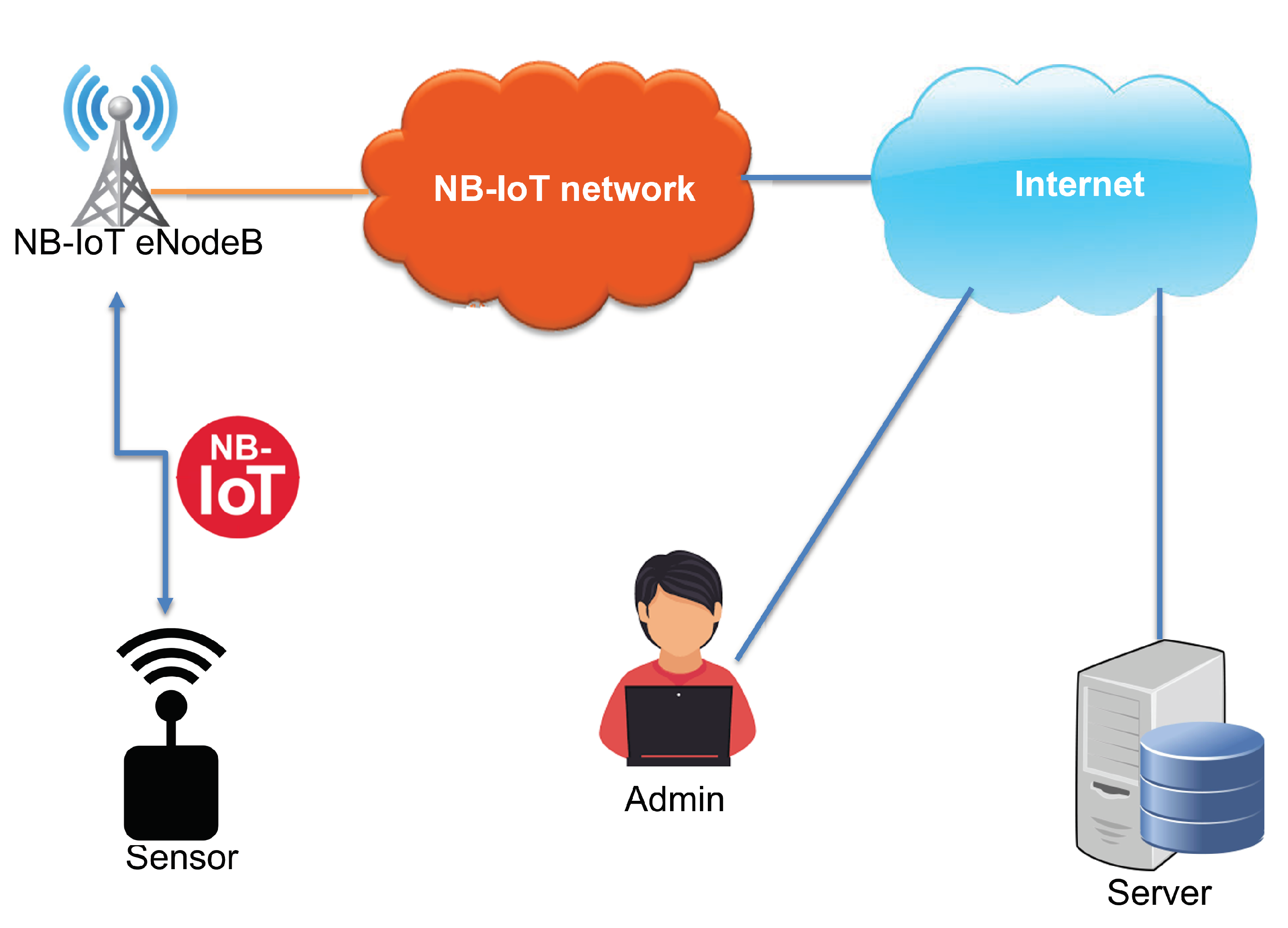
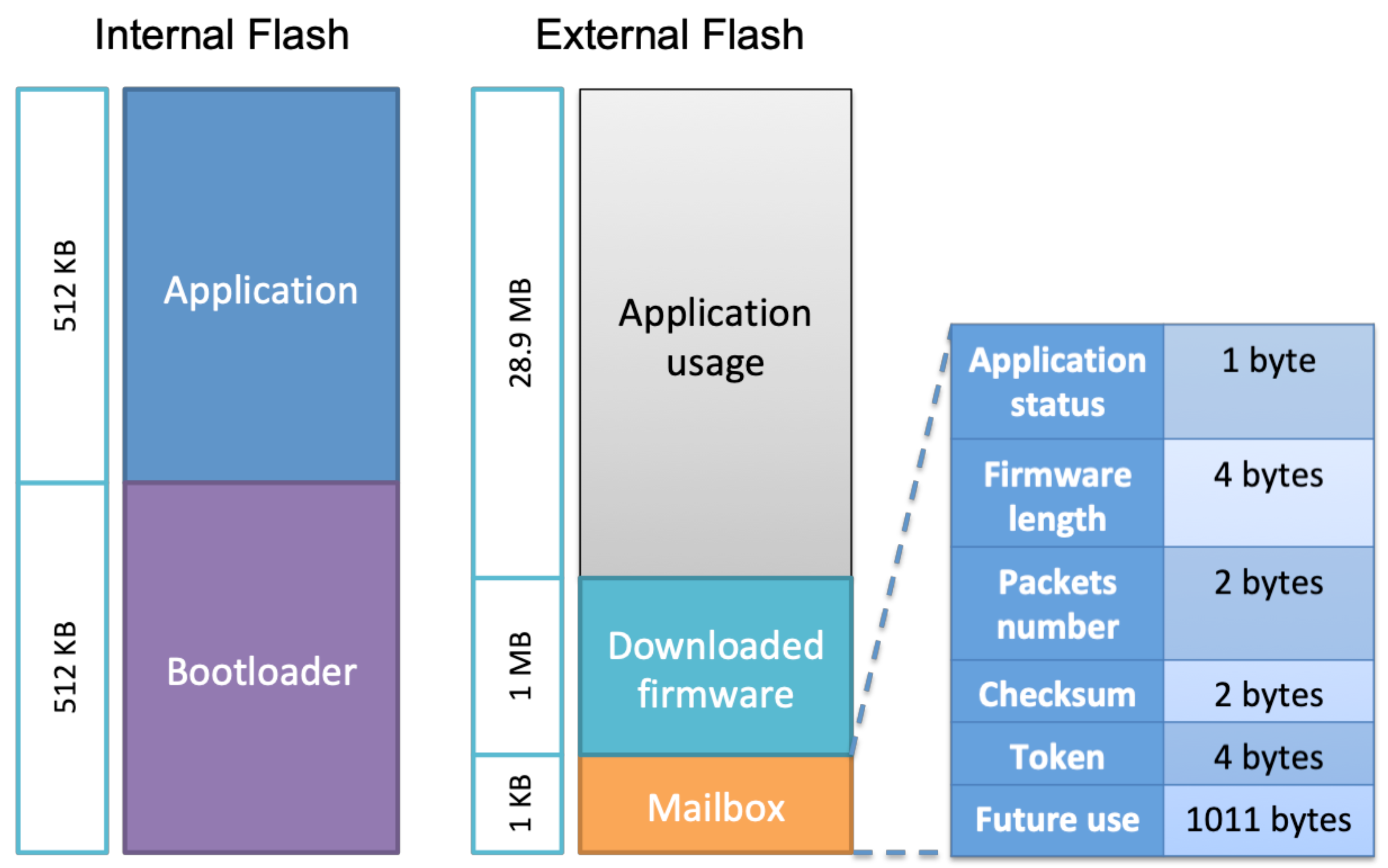
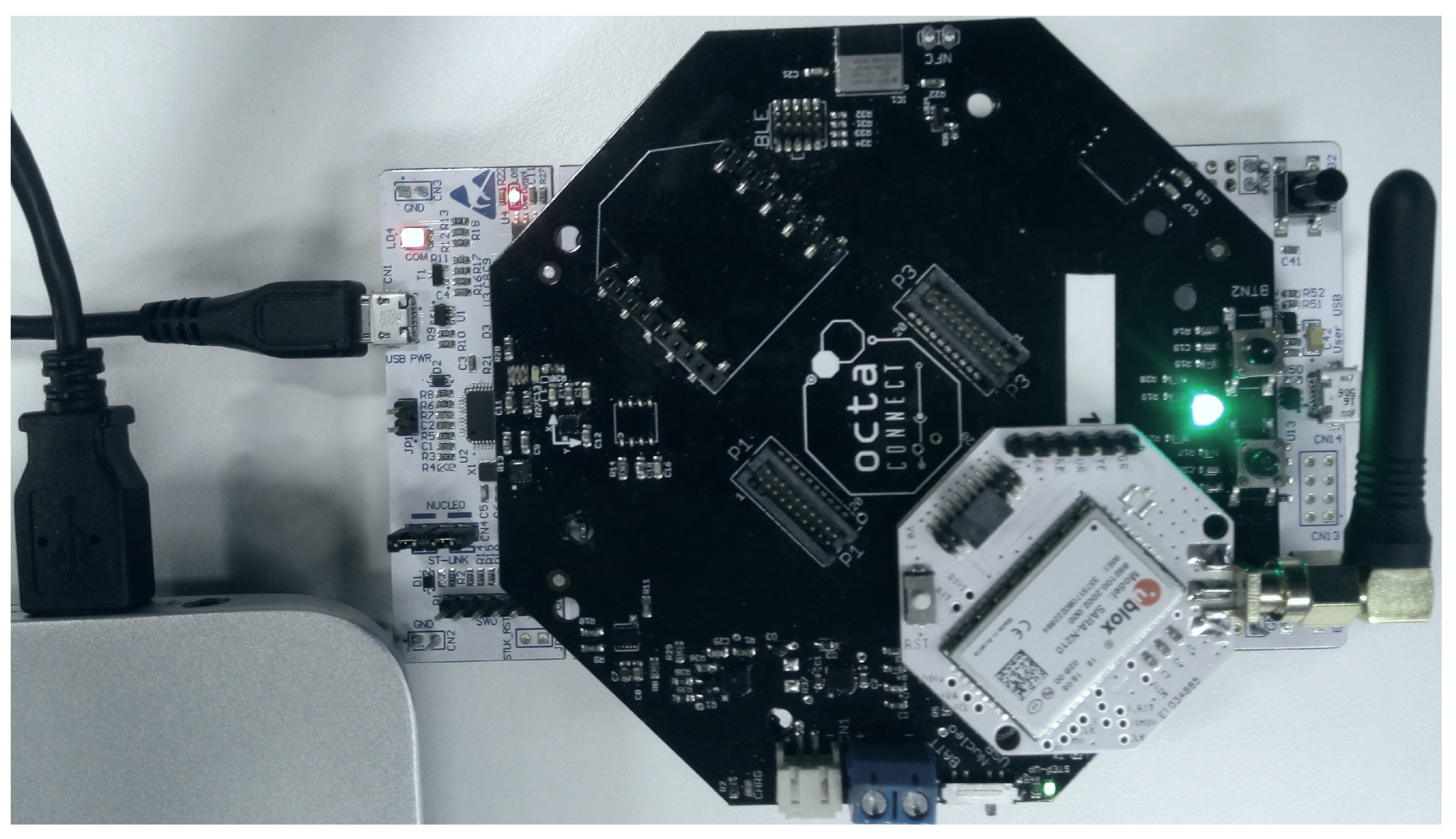
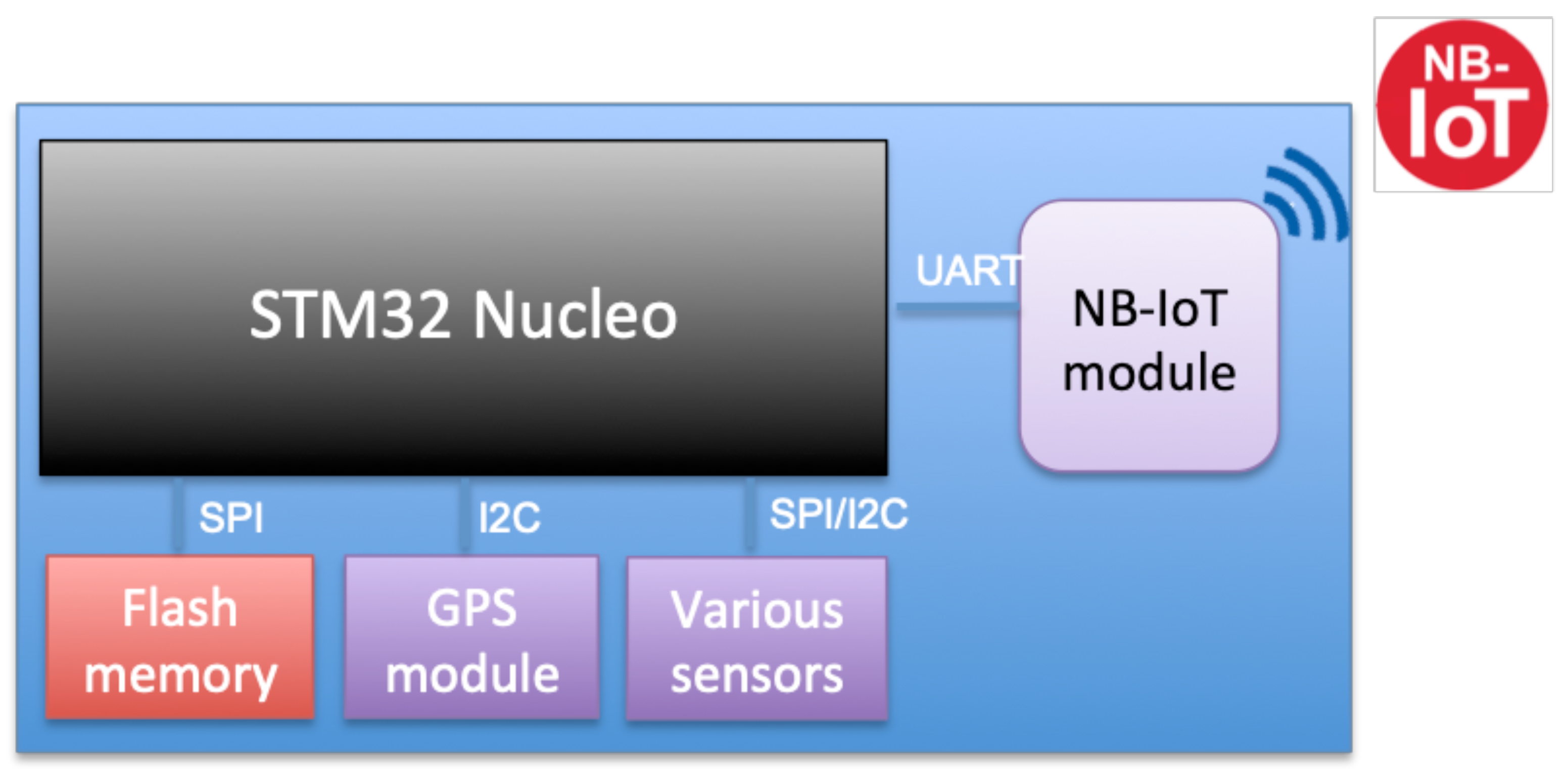

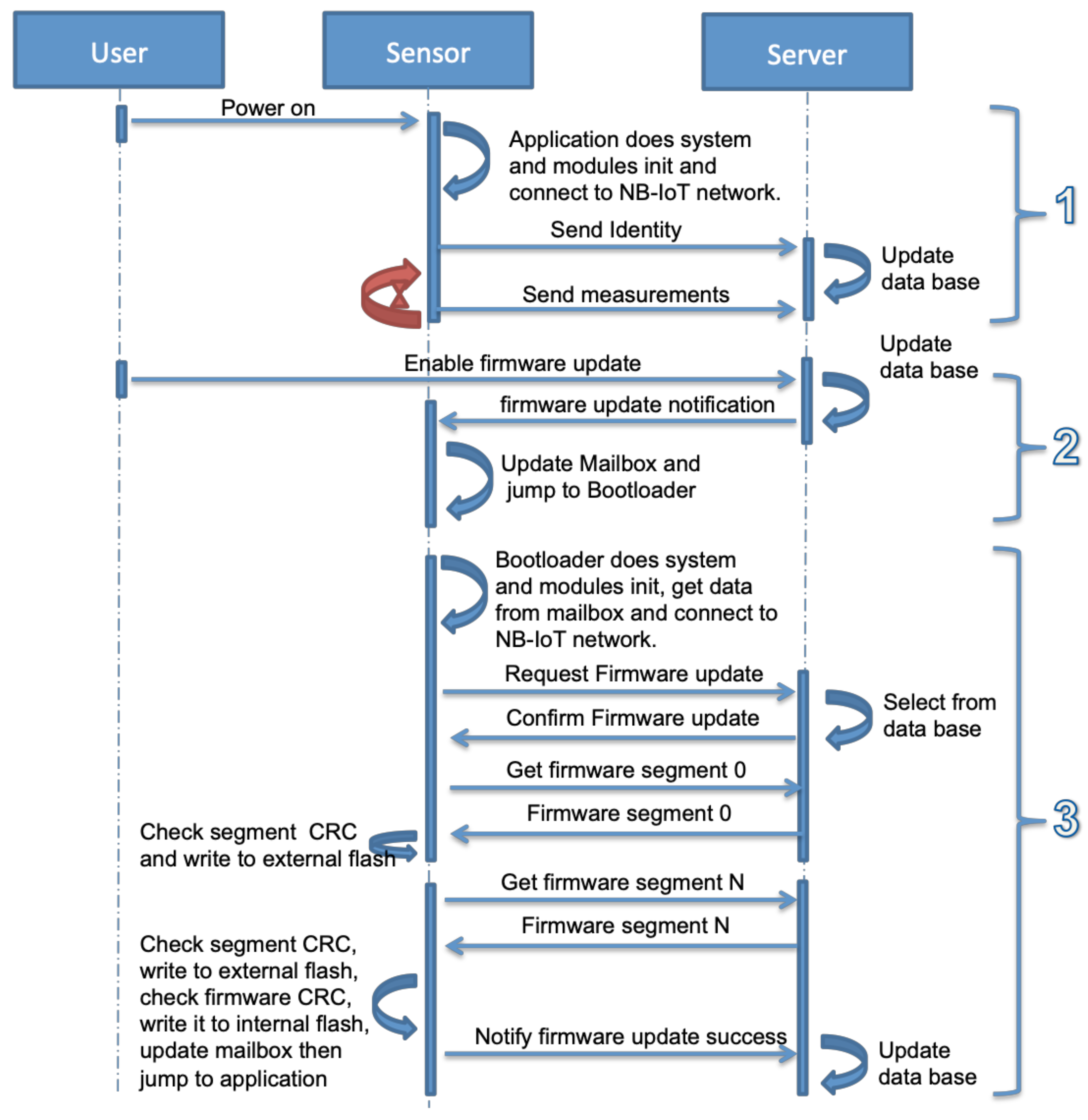


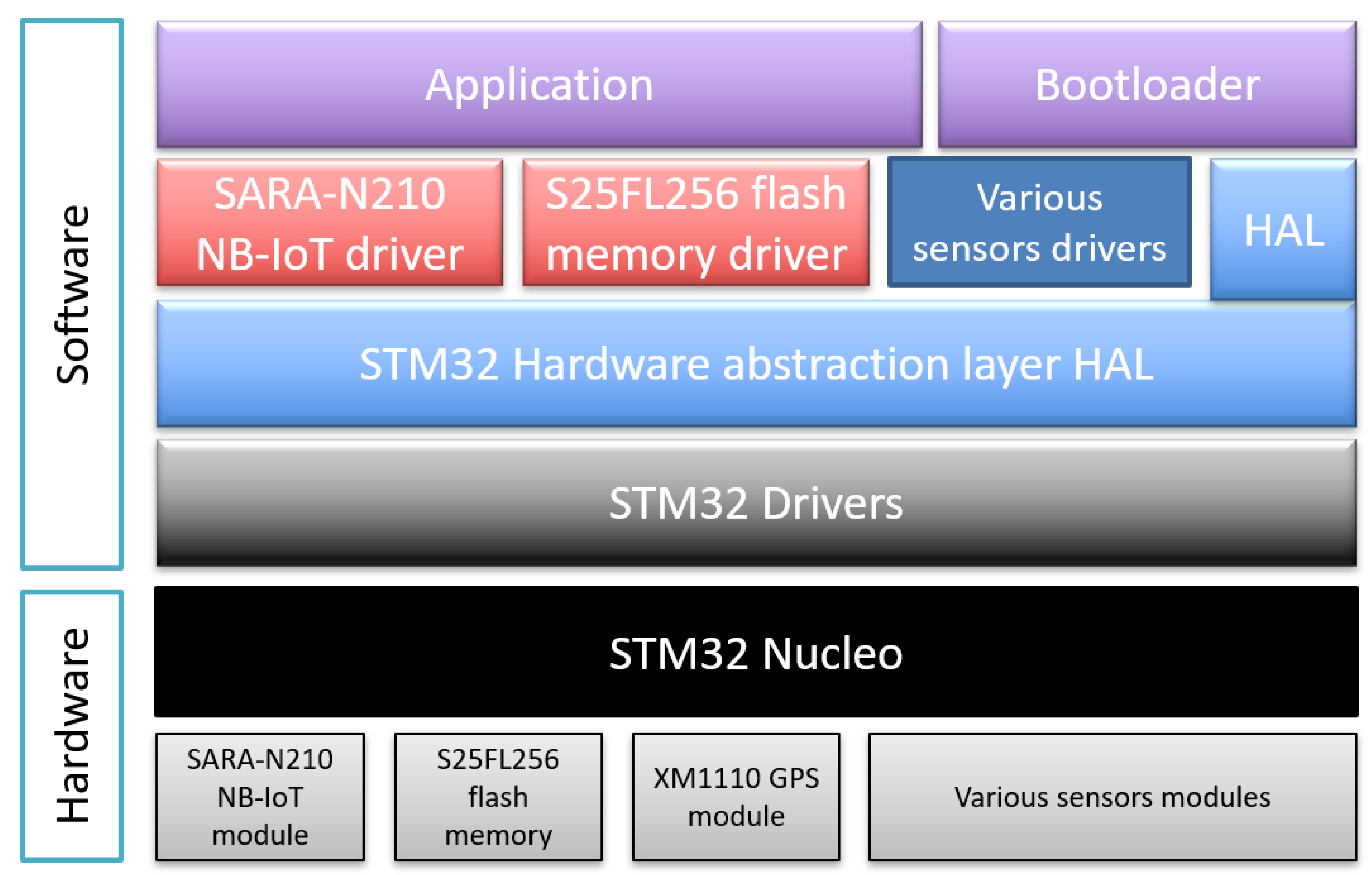

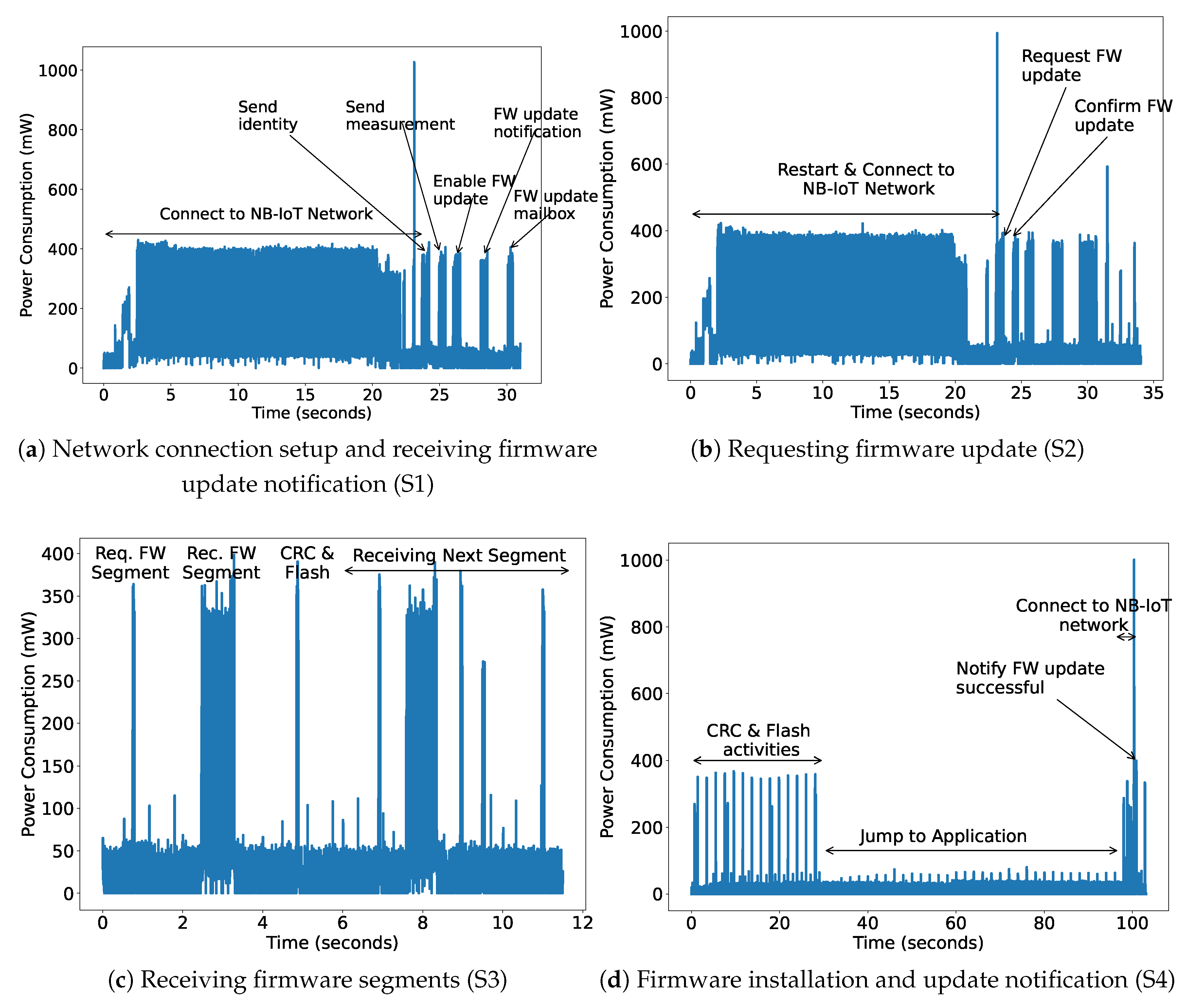
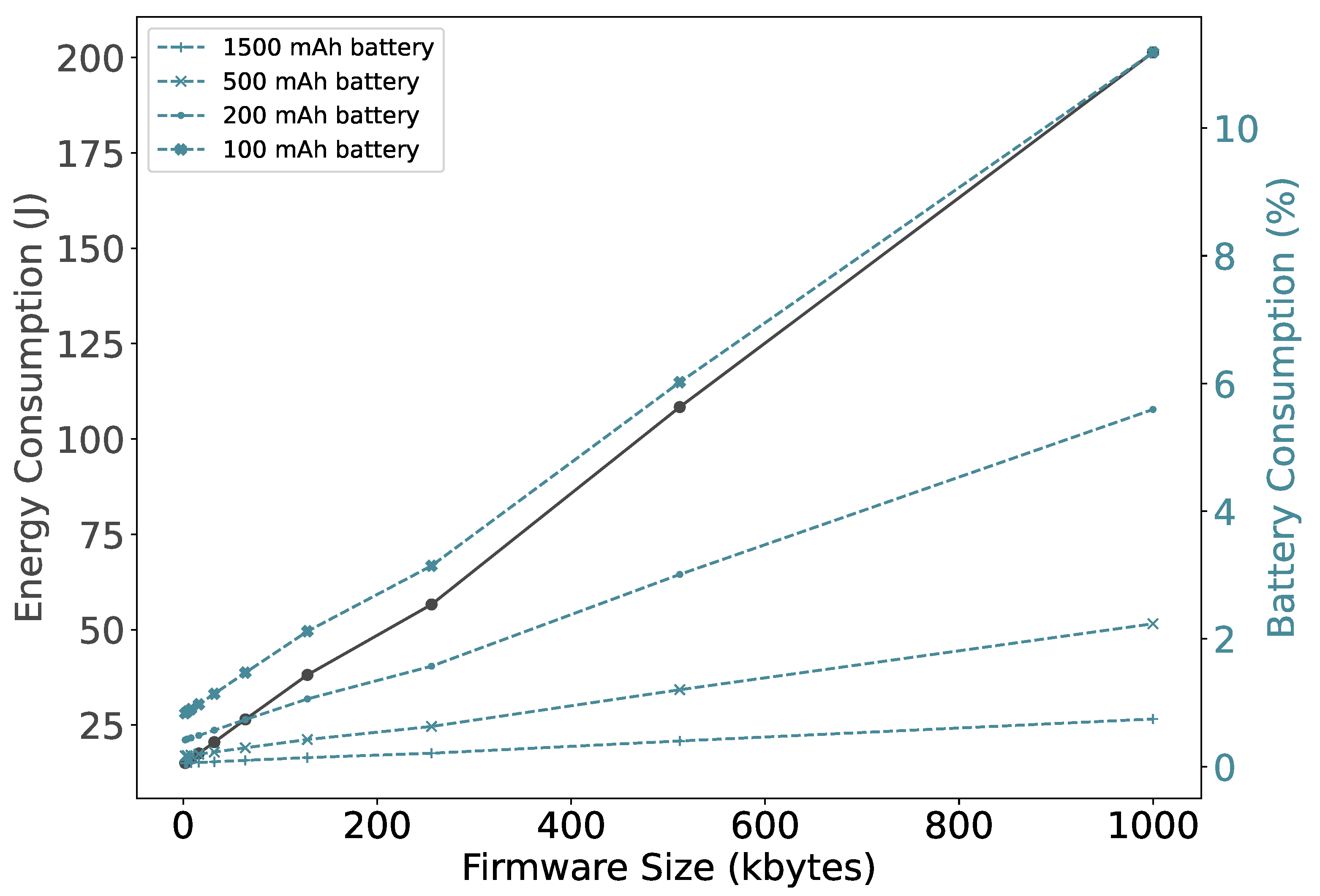
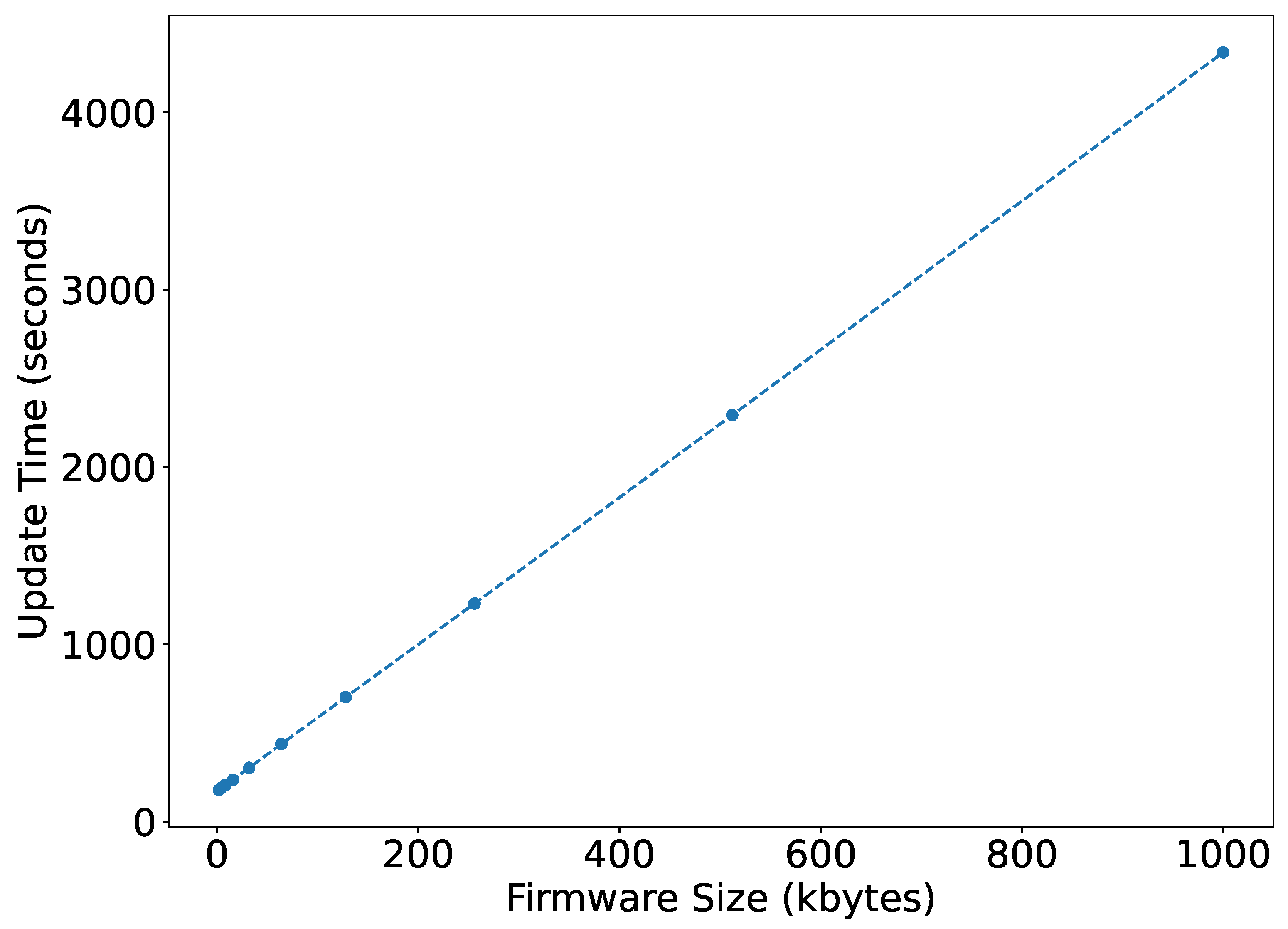
| Status | Signification |
|---|---|
| OK | The application firmware is updated and valid. The CPU should now jump to the sensor application. |
| Firmware update request | A firmware update notification is received from the server and the bootloader should perform the firmware update process. |
| Firmware downloaded | New firmware is downloaded by the bootloader from the server and not yet flashed in the internal flash memory. The bootloader should copy the downloaded firmware into the internal flash memory. |
| Error | The firmware is corrupted for some reason. The bootloader should again perform a firmware update to recover the corrupted sensor application firmware. |
| Entities | Message Type | Message Format |
|---|---|---|
| Application to server | Sensor identity | Sensor#<IMEI>#<IP>#<Software Version>#<Timestamp> |
| Measurement | Measurement#<IMEI>#<sensors values>#<Timestamp> | |
| Server to application | Firmware update notification | FirmwareUpdate#<CRC>#<Length>#<Packets number>#<Token> |
| Bootloader to server | Request Firmware update | RequestFirmwareUpdate#<Token> |
| Get Firmware segment | GetSegment#<Index> | |
| Notify Firmware update status | FirmwareUpdateStatus#<Status> | |
| Server to bootloader | Confirm/reject Firmware update request | FirmwareUpdateConfirm or FirmwareUpdateReject#<Reason> |
| Send Firmware segment | <Segment message Id><Length><Index><Data><CRC> |
| State | Average | Time | Power Con. |
|---|---|---|---|
| Current Con. | (s) | (mW) | |
| (mA) | |||
| Initialize, send sensor data and enable FW update | 43.488 | 31.01 | 217.44 |
| Initialize and Request FW update | 38.193 | 34.02 | 190.96 |
| Request, receive and save one FW segment | 9.044 | 5.18 | 44.85 |
| Complete FW CRC and Flash activities | 3.134 | 29.01 | 15.67 |
| Jump to application (Idle state) | 1.924 | 69.74 | 9.62 |
| Tx FW update notification | 10.311 | 4.30 | 51.55 |
Publisher’s Note: MDPI stays neutral with regard to jurisdictional claims in published maps and institutional affiliations. |
© 2022 by the authors. Licensee MDPI, Basel, Switzerland. This article is an open access article distributed under the terms and conditions of the Creative Commons Attribution (CC BY) license (https://creativecommons.org/licenses/by/4.0/).
Share and Cite
Mahfoudhi, F.; Sultania, A.K.; Famaey, J. Over-the-Air Firmware Updates for Constrained NB-IoT Devices. Sensors 2022, 22, 7572. https://doi.org/10.3390/s22197572
Mahfoudhi F, Sultania AK, Famaey J. Over-the-Air Firmware Updates for Constrained NB-IoT Devices. Sensors. 2022; 22(19):7572. https://doi.org/10.3390/s22197572
Chicago/Turabian StyleMahfoudhi, Farouk, Ashish Kumar Sultania, and Jeroen Famaey. 2022. "Over-the-Air Firmware Updates for Constrained NB-IoT Devices" Sensors 22, no. 19: 7572. https://doi.org/10.3390/s22197572
APA StyleMahfoudhi, F., Sultania, A. K., & Famaey, J. (2022). Over-the-Air Firmware Updates for Constrained NB-IoT Devices. Sensors, 22(19), 7572. https://doi.org/10.3390/s22197572








